Physics of Archery
Physics of Archery
The word physics comes to us from the Greek φυσική meaning “knowledge of nature”. Physics is considered a fundamental discipline in science. It is the study of matter and its behavior. Students of physics seek to understand the behavior of the universe. This article discusses the physics of archery, from fundamental principles to more advanced experiments.

Archery involves several aspects of physics. the storage, transfer, and delivery of energy. It is therefore subject to the realm of physics much like anything else. Bow builders and archers of the past would have been very much aware of some physical phenomena involved in archery. They may not have had sophisticated modeling software or highly accurate and sensitive instruments to take particular measurements of observed processes, however, they would have been observing nonetheless.
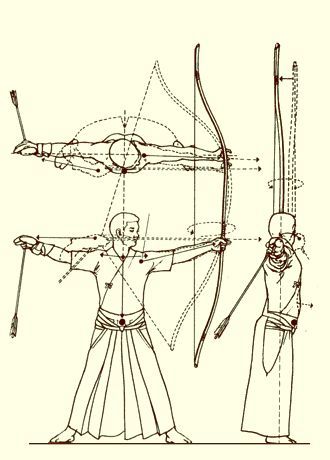
A bow that is harder to draw, shoots an arrow faster and farther than a lighter bow. A lighter arrow on the same bow will also travel farther and faster. It would be safe to assume these observations would have been made early on in the history of archery. Luckily, these days, we’ve come a long way in terms of our technology and ability to make accurate measurements of what we observe.
Much like our ancestors have done, let us utilize what we have at our disposal to better understand our world, and in particular, the world of archery.
Bow and Arrow Energy Transformation
What is energy? Indeed this is hard to define. Modern science gives great descriptions of what energy can do, however, what energy actually seems to be, is more difficult to explain.
The Wikipedia entry for energy reads: “In physics, energy is the quantitative property that must be transferred to an object in order to perform work on, or to heat, the object.”
A quantitative property transferred to an object in order to perform work on it. OK, so what then is “work”? Following the rabbit-hole, this is the entry for “work” as it relates to physics:
“In physics, work is the energy transferred to or from an object via the application of force along a displacement.”
So you can see the circular nature of the way we define things sometimes gets us into trouble. Despite the lack of clarity with regards to defining energy, we all observe the effects of energy transfer in our day to day lives. Electrical energy is converted to heat to boil our water to make tea. Chemical energy inside our gasoline is converted to kinetic energy which moves our cars. Or perhaps you drive an electric car, in which case electrical energy is transformed into rotational kinetic energy which turns your wheels. Also, there is one special instance of energy transfer that is likely near and dear to our readers, and that is the shooting of an arrow with a bow!
The Conservation of Energy
The bow is a device that stores and transfers energy. Potential energy is transferred to kinetic energy once the string is released. This kinetic energy is transferred from the bow to the arrow, which in turn transfers its inherited kinetic energy into the target.
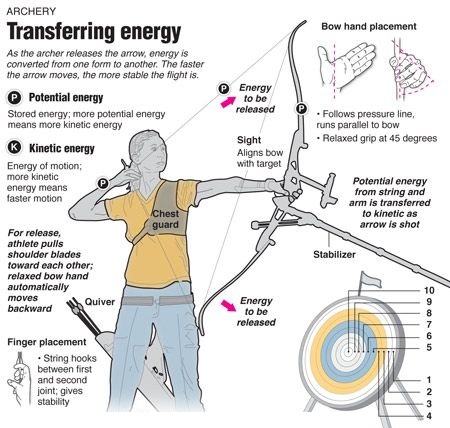
This brings us to our first important note on the physics of archery, which is called conservation of energy.
The principle of the conservation of energy states that the energy in an isolated system can neither be created nor destroyed. Energy can only be transformed.
You may also hear of the “first law of thermodynamics”, which is basically the law of conservation of energy applied to thermal systems and processes. An interest in energy and the behavior of heated bodies increased during the 1800s as steam engines helped usher in the industrial revolution.
In any event, the important thing to note is that a bow acts essentially as a spring, storing energy that has the potential to be released and transferred to kinetic energy.
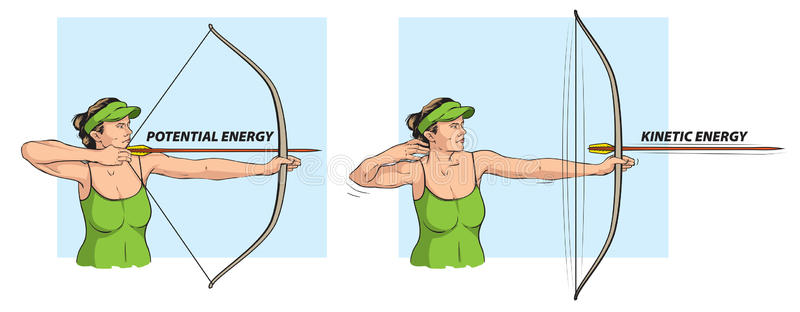
How Much Energy? Graphs & Diagrams
Now let us use physics’ best friend, mathematics to help give us a better understanding of the storage of energy of a bow.
In another blog article at archeryhistorian.com titled “how-to-measure-draw-weight-of-a-bow”, we discussed force-draw (f/d) graphs. A force-draw graph is developed by measuring the force on the bowstring at various incremental distances along the draw path of the bow. Typically, the force is measured with a weight scale at 1-inch increments to full draw (28 inches). Below is an example of an f/d graph for three different bows.
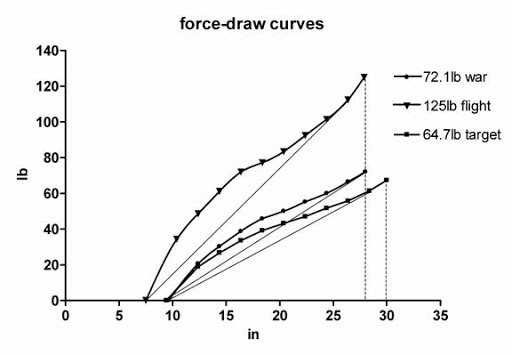
Calculating the area under the curve produced by an f/d diagram gives the potential or stored energy that is available to restore the bow limbs and propel the arrow forward.
As an example, if we calculate the area under the curve of the target bow, we may arrive at a number such as 63.5 foot-pounds. Now if we divide this value by the peak draw force at max draw we get:
63.5 foot-pounds / 64.7 pounds = 0.98 foot-pounds per pound (0.98 ft-lb/lb)
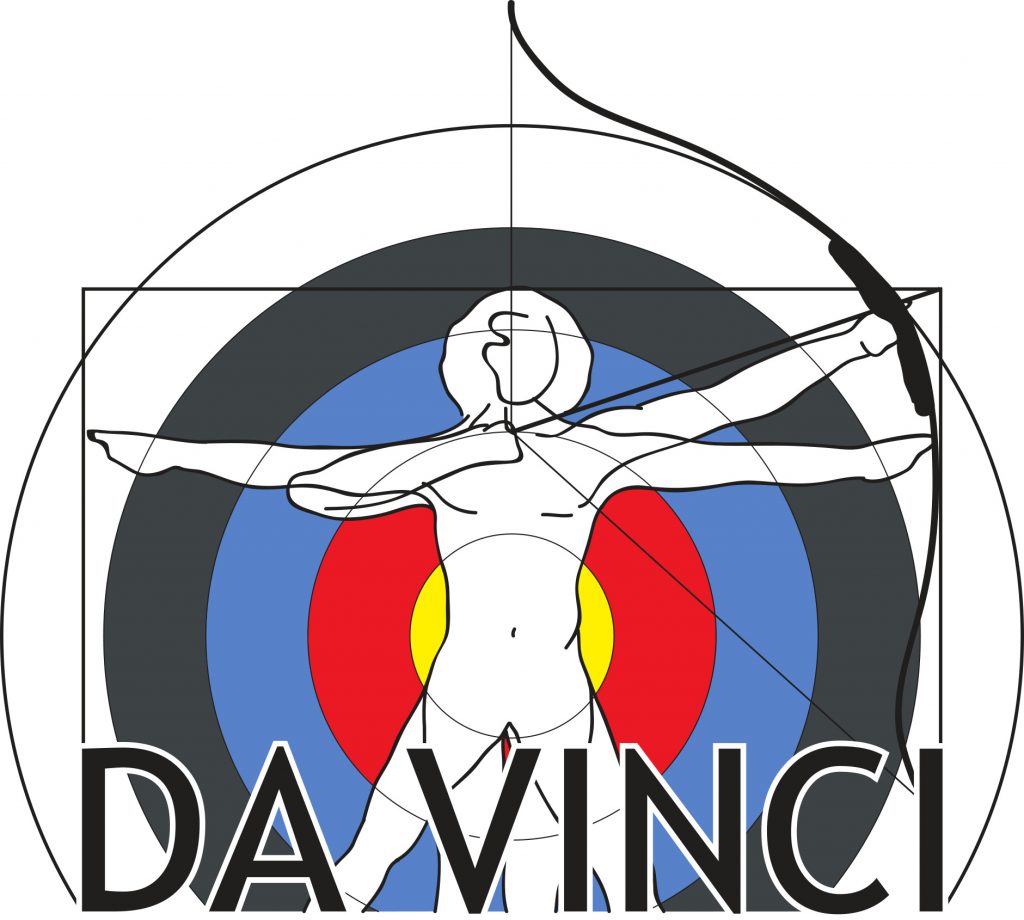
Physics of Bow Efficiency: Hysteresis
Hysteresis is a term in physics and engineering which refers to the unrecoverable loss of energy in a system. This energy may escape a mechanism such as a bow through heat, resistance with the air, internal friction, recoil, etc. Substracting these losses from the measurement of stored energy as done in a force-draw calculation/diagram, we can get a better idea of the efficiency of a bow.
The measurements to obtain the data points are done as follows:
- we take the draw force of the bow from brace height to full draw as done to get the data points for the force-draw curve
- once the bow is at full draw, we take the second set of force/weight measurements from full draw, back to the brace height. These measurements are taken at the same location as the first set of measurements when we went from brace height to full draw
- plot these data points on a graph
Hysteresis Graph
An example of plotted data points using the above-mentioned procedure my look like this:
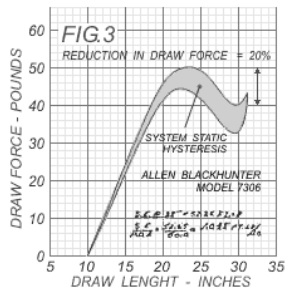
Some interesting things may be noted. Firstly, the upper curve represents the data obtained when drawing the bow to its maximum draw length. The lower curve represents the data points gathered when the bow traveled from full draw, back to the brace height. One thing becomes apparent upon first observation. The force on the string on the way back down from full draw is lower than on the way from brace height to full draw.
The area bound within these two curves is known as the hysteresis loop. This loop is known as “static hysteresis” since the measurements are taken when the bow is static (at rest). Kinetic friction or friction of motion would generally be less than this measured static friction. If one were able to measure for and plot a hysteresis loop when the bow is being shot, the hysteresis loop would be significantly smaller in area.
The hysteresis curve can be valuable for comparing efficiencies between bows. From an engineering standpoint, the bow with the highest static hysteresis would have a higher kinetic hysteresis and therefore a lower efficiency.
Physics of Archery: Shooting Performance
Now for some serious math and physics. The measurements and calculations above will allow us to determine the stored energy efficiency of a bow, but what about the energy it imparts on the arrow? The true measure of a bow’s efficiency can be calculated by dividing the kinetic energy of a fired arrow by the stored energy of the bow.
Now for some more math fun! Physics gives us the formula for the kinetic energy of a moving body at an instant as:
Kinetic Energy = KE = ½mV²
m= mass of body (in slugs)
V= velocity in feet per second
Slugs is a British engineering term for absolute mass. It is taken by dividing the weight in pounds by the acceleration of gravity (32.16 ft/sec). However, arrow weights are usually measured in grains, where 1 pound = 7000 grains. Our new and improved formula looks for the kinetic energy of an arrow looks like this:
KE (ft-lbs) = WV²/450240
W= weight in grains
V= velocity in feet per second
The 450240 was obtained by multiplying 7000 (number of grains per 1 pound) by the acceleration of gravity (32.16 ft/sec) and multiplying by 2.
Arrow Physics
For measuring the arrow velocity we can use a chronograph which uses light and sensitive electronics to measure the speed of an object typically passing above it. Several variants are built specifically to measure projectiles from bows of firearms.
Knowing the speed and the weight of the arrow we can easily calculate to kinetic energy using the above formula: KE (ft-lbs) = WV²/450240 (formula 1)
Now for the grande finale: We divide the arrow’s energy by the bow’s stored energy to get the energy efficiency of the bow in relation to how much of the stored energy is transferred to the arrow.
Bow Efficiency = (KE(arrow) / E (stored bow energy) ) x 100 (formula 2)
Let’ say we measure an arrows kinetic energy as 35 ft-lbs and the bows stored energy as 40 ft-lbs.
The efficiency would be (35 / 40) x 100% = 87.5 %

Arrow Mass & The Physics of Archery
The measure of efficiency for a particular bow can be given as a ratio of the kinetic energy of an arrow leaving the bow to the energy stored in the bow at full draw. Therfore a formula for bow efficiency may be written as: E(efficiency) = (KE(arrow energy)/ BE(stored bow energy). We could rewrite this formula for KE (arrow energy) as KE= BE * E / 100. Substituting with formula 1 (KE (ft-lbs) = WV²/450240) we have:
WV²/450240 = BE * E / 100
This math is all fun but what does this mean in real world terms. Well as any archery would surely tell you, a lighter arrow would fly faster from a particular bow. What is not commonly discussed however is that a bow will deliver more of it’s stored energy to a heavier arrow. More of the stored energy goes into the projectile and less energy is absorbed by the bow itself when the arrow weight increases. Of course there is a limit and a peak of maximum efficiency and a certain weight will be reached with an arrow where efficiency will begin to fall off.
Physics of Archery Projectile Motion
Now let us discuss some of the physics behind the movement of the arrow! As you may or not be aware, arrows oscillate laterally as they leave the bow. These lateral oscillations come about as a result of the force pushing the arrow as it is loosed as well as the arrow having certain flexibility. This ability to bend is known as “spine” in archery terminology. You can see an arrow swimming through the air in slow-motion footage.
The amount of deflection of the arrow as it travels is a function of several factors. These include the flexibility of the arrow shaft, the mass of the arrow shaft and tip, as well as the force with which the arrow is propelled forward, which is a function of the draw weight of a bow.
The arrow must have a minimum stiffness in order to not be destroyed by the force acting upon it upon release. There is a sweet spot with regards to the arrow spine and draw weight. The spine of an arrow is measured by suspending it at two points and measuring the deflection produced by attaching a weight to the center of the arrow. The Archery Trade Association (ATA) defines spine as: “Spine is the number of thousands of an inch by which the center of an arrow shaft of 28-inch length is displaced when a sideways force of 1.94 pounds is acting at that point”.

When the arrow is loosed it will oscillate. It will move side to side or up and down in the case of compound bows. Two nodes will however remain relatively unmoved as the arrow flies.
Further Reading on the Physics of Archery
Most of the information has been sourced by these two studies. Click the links for the PDF.
Applications of Physics to Archery
H. O. Meyer
Physics Department, Indiana University
meyer1@indiana.edu
(6 November 2015)
